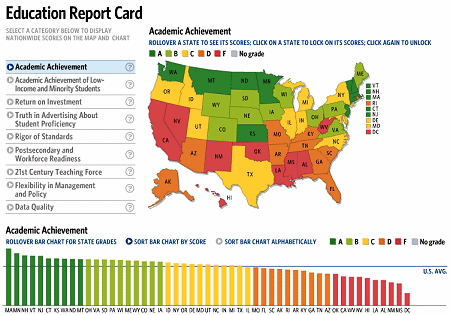Report card on education in the US states
By Murray Bourne, 09 Apr 2007
Here is an interesting report from the US Chamber of Commerce, giving a view of educational outcomes in each US state from a business point of view: Leaders and Laggards: A State-by-State Report Card on Educational Effectiveness [no longer available].

It is noteworthy that the worst performing state is Washington, DC (it's the small red bar on the far right of the image).
The metric "21st Century Teaching Force" caught my eye. I thought it may have been talking about the use of technology to enhance learning, but no - it was just referring to whether the state had in place the following testing for teachers:
- State requires teachers to pass basic tests ("strong academic fundamentals")
- State requires teachers to pass subject knowledge tests ("teachers need strong content knowledge in the subjects they teach")
- State has an alternative route program to recruit college graduates ("attracting second-career professionals")
- State requires alternative route teachers to show subject matter expertise through test.
Wow. I thought they were all a given for any education system. But 14 states only made a grade of C, D or F.
There are no clear data on what states are doing to evaluate teacher performance, reward good teachers, make it easier for talented candidates to compete for jobs, or remove ineffective educators.
Some of the conclusions in the accompanying report are well known:
The measures of our educational shortcomings are stark indeed; most 4th and 8th graders are not proficient in either reading or mathematics.
And
Only about two-thirds of all 9th graders graduate from high school within four years. And those students who do receive diplomas are too often unprepared for college or the modern workplace.
Some of the Report's conclusions are troubling:
The state of education data remains abysmal. No business could be run with such inadequate information. Can we imagine Southwest Airlines reshaping the airline industry without precise metrics on cost per passenger mile? Could General Electric have employed its highly productive defect-reduction approach so efficiently without rigorous employee evaluations and detailed data on error rates?
Yet such data continue to elude educational leaders. Not a single state can provide systematic data on how many teachers are being rewarded for essential skills or the quality of their work, how cost effective a remedial program in one district is compared with a similar program in another district, or how many teachers were terminated last year for poor performance.
A very interesting report from examiners who are independent of the educational system.
Be the first to comment below.